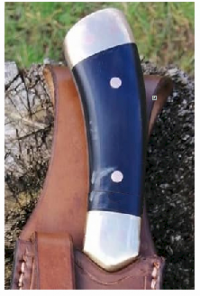Feedback?
Its a very nice looking knife. Sheath looks very tidy too. Like the stitching. Hard to tell about some aspects from the photos, perspective can play tricks.
A bang on square side view doesn't tend to look as good for marketing, but does help for understanding the shape.
Tend to think that butt and bolster would look better with a matching shape, either both rounded or both angular. Not sure, but looks like the apex of the bolster is a little low (towards cutting edge side). This could be optical, pins mounted dead centre in handles can look low, lots of people shift them 1mm or so towards the spine to counter that, I might have done the same on the angled front of the bolster.
From the hamon, it looks like the edge at the plunge didn't harden. Was this intentional? I know I have had trouble on some blades with change in section at the ricasso interfering with heating/quenching in that area. I like being able to cut pretty close to the handle, so that wasn't desirable for me.
I think there could be advantages to running the grind off the back of the ricasso, and shortening the ricasso accordingly. This would mean more sharpening life before the blade starts to get a recurve. It could help with hardening, and move the edge closer to the hand, better leverage on hard cuts. If the heel of the blade is then radiused, say 3mm, there isn't much danger of cutting oneself.
I have read that brine is pretty fierce on 1095 and the main reason for using it is to get really wild hamons using clay. Is that where you are headed?
Big brass bolsters look great. A couple of my earliest knives used the front end bolsters. Never did it again because of the weight, which helped neither balance nor chopping in my case. I reckon you could have had a smaller front bolster and it would still look good. Tried a phot-shop with about 1/4" off the bolster, and moving the apex towards the spine. Think the first pin looks less crowded like this too.
View attachment 65757
Really nice looking knife.

Thank you for sharing!!
Chris



 Thank you for sharing!!
Thank you for sharing!! . My bad that I misunderstood. When you said you had designed the knife a year ago and made only three, I thought you meant this was your first knife with 1095 and a hamon.
. My bad that I misunderstood. When you said you had designed the knife a year ago and made only three, I thought you meant this was your first knife with 1095 and a hamon.